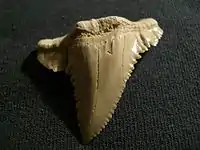Palaeocarcharodon
Palaeocarcharodon, also known as the pygmy white shark, is a genus of shark within the family Otodontidae[1] that lived about 61.7 to 55.8 Ma during the Paleocene. It currently contains a sole species P. orientalis.[2]
| Palaeocarcharodon Temporal range: Paleocene, | |
|---|---|
 | |
| Fossil teeth of Palaeocarcharodon orientalis (the largest three) from Khouribga (Morocco), alongside teeth of Otodus | |
| Scientific classification | |
| Domain: | Eukaryota |
| Kingdom: | Animalia |
| Phylum: | Chordata |
| Class: | Chondrichthyes |
| Order: | Lamniformes |
| Family: | †Otodontidae |
| Genus: | †Palaeocarcharodon Casieer, 1960 |
| Species: | †P. orientalis |
| Binomial name | |
| †Palaeocarcharodon orientalis (Sinzow, 1899) | |
Description
Teeth of Palaeocarcharodon are triangular, labio-lingually compressed, with quite irregular serrations and serrate lateral cusplets. They can reach a size of about 3–6 centimetres (1.2–2.4 in).[3]
 Tooth of Palaeocarcharodon from Atlas mountain in Morocco. 60 mya, long 3 cm.
Tooth of Palaeocarcharodon from Atlas mountain in Morocco. 60 mya, long 3 cm.
References
- Mikael Siverson; Johan Lindgren; Michael G. Newbrey; Peter Cederström; Todd D. Cook (2013). "Cenomanian–Campanian (Late Cretaceous) mid-palaeolatitude sharks of Cretalamna appendiculata type". Acta Palaeontologica Polonica. 60 (2): 339–384. CiteSeerX 10.1.1.1027.6182. doi:10.4202/app.2012.0137. S2CID 58906204.
- Kordikova, E. G.; Polly, P. D.; Alifanov, V. A.; Roček, Z.; Gunnell, G. F.; Averianov, A. O. (2001). "Small vertebrates from the Late Cretaceous and early Tertiary of the northeastern Aral Sea Region, Kazakhstan" (PDF). Journal of Paleontology. 75 (2): 390–400. doi:10.1666/0022-3360(2001)075<0390:svftlc>2.0.co;2. S2CID 92986827.
- G. R. Case. - Palaeocarcharodon Orientalis (SINZOW) (Neoselachii: Cretoxyrhinidae), from the Paleocene of Maryland - Lab. de Paléontologie des Vertébrés, 1989
This article is issued from Wikipedia. The text is licensed under Creative Commons - Attribution - Sharealike. Additional terms may apply for the media files.